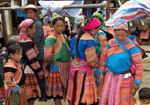

The Hmong's history and social life in Sapa

The Hmong, known for centuries in China by the name of Miao, used to be
called the Meo in Southeast Asia. Numbering about three million, they
are scattered over a vast territory stretching from south-west China (2
million) to north Vietnam (600,000), Laos (about 250,000), Thailand
(150,000) and Myanmar (formerly Burma) (about 30,000).
The main subgroups present in Vietnam are the White Hmong, the Hmong Leng, Hmong Pua, Hmong Shi or Sheu and the black Hmong. In
Sa Pa, the Hmong Leng are the most numerous, some Hmong Sheu and Hmong Pe women with their colourful skirts and double-breasted tops come from the
Muong Khuong district.
Originally, the Chinese hmong populations used to live in the wide plains south of the Yangtse river. As of the 16th century, they started to migrate to the south-east under the demographic, territorial and political pressure of the Chinese. During the first half of the 19th century, the Hmong left the Chinese territory and settled in neighbouring countries. At the time, the great Taiping rebellion (1850-1872) was disturbing all southern China (Guizhou, Yunnan and Sichuan provinces) causing long periods of famine that pushed numerous ethnic groups to go south. The Hmong entered the Indo-Chinese peninsula through North Vietnam, their presence near Lai Chau was reported in 1848. These successive waves of migration were probably facilitated by the hmong tradition of shifting cultivation and their close contacts with the Chinese caravaneers who had been travelling for centuries through the mountains of southern Asia.
Today, the traditional agrarian economy is still based on family farms raising pigs, chickens, buffaloes and horses, on food crops (rice, corn, manioc) and cash crops (cardamom and vegetables).
The traditional social organisation of the Hmong is based on the clan. Each clan is made of lineages, all the members of which acknowledge a common founding male ancestor. In the Hmong household, up to four different generations may be gathered under the same roof. The household is the most important economic, political and ritual unit. The villages perched on the mountain slopes house several clans.
Easily recognisable by their costume, the Sa Pa Hmong Leng who do not call themselves Black Hmongs still wear hemp clothes dyed with natural (black-blue) indigo. The women wear stiff indigo-blue turbans over their hair gathered into a bun. Nowadays, they hardly ever wear their batik or embroidered pleated skirts, replaced with short indigo pants. Only the collar, sleeves and belt are embroidered with geometric patterns in silk. The White Hmong women from the Bat Xat district wear long black pants, fairly short-waisted double-breasted jackets, and cover their hair with colourful head scarves. The Hmong Pua, Hmong Pe and Hmong Sheu women from the Bac Ha district wear similar batik skirts with an embroidered band. They are distinguished by the decorative patterns and shape of their aprons.
Originally, the Chinese hmong populations used to live in the wide plains south of the Yangtse river. As of the 16th century, they started to migrate to the south-east under the demographic, territorial and political pressure of the Chinese. During the first half of the 19th century, the Hmong left the Chinese territory and settled in neighbouring countries. At the time, the great Taiping rebellion (1850-1872) was disturbing all southern China (Guizhou, Yunnan and Sichuan provinces) causing long periods of famine that pushed numerous ethnic groups to go south. The Hmong entered the Indo-Chinese peninsula through North Vietnam, their presence near Lai Chau was reported in 1848. These successive waves of migration were probably facilitated by the hmong tradition of shifting cultivation and their close contacts with the Chinese caravaneers who had been travelling for centuries through the mountains of southern Asia.
Today, the traditional agrarian economy is still based on family farms raising pigs, chickens, buffaloes and horses, on food crops (rice, corn, manioc) and cash crops (cardamom and vegetables).
The traditional social organisation of the Hmong is based on the clan. Each clan is made of lineages, all the members of which acknowledge a common founding male ancestor. In the Hmong household, up to four different generations may be gathered under the same roof. The household is the most important economic, political and ritual unit. The villages perched on the mountain slopes house several clans.
Easily recognisable by their costume, the Sa Pa Hmong Leng who do not call themselves Black Hmongs still wear hemp clothes dyed with natural (black-blue) indigo. The women wear stiff indigo-blue turbans over their hair gathered into a bun. Nowadays, they hardly ever wear their batik or embroidered pleated skirts, replaced with short indigo pants. Only the collar, sleeves and belt are embroidered with geometric patterns in silk. The White Hmong women from the Bat Xat district wear long black pants, fairly short-waisted double-breasted jackets, and cover their hair with colourful head scarves. The Hmong Pua, Hmong Pe and Hmong Sheu women from the Bac Ha district wear similar batik skirts with an embroidered band. They are distinguished by the decorative patterns and shape of their aprons.
Read More
Sapa town (01/09/2008)
The town(01/08/2008)
Travelling to Sapa(01/08/2008)
The surprises of scenic Sapa(01/08/2008)
Sapa climate(01/04/2008)
The Tay's history and social life(01/04/2008)
The Dao's history and social life in Sapa(12/29/2007)
See also
Sapa history(12/19/2007)





